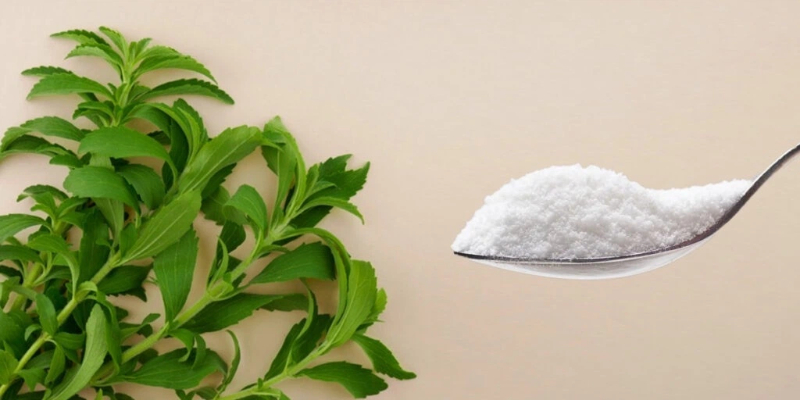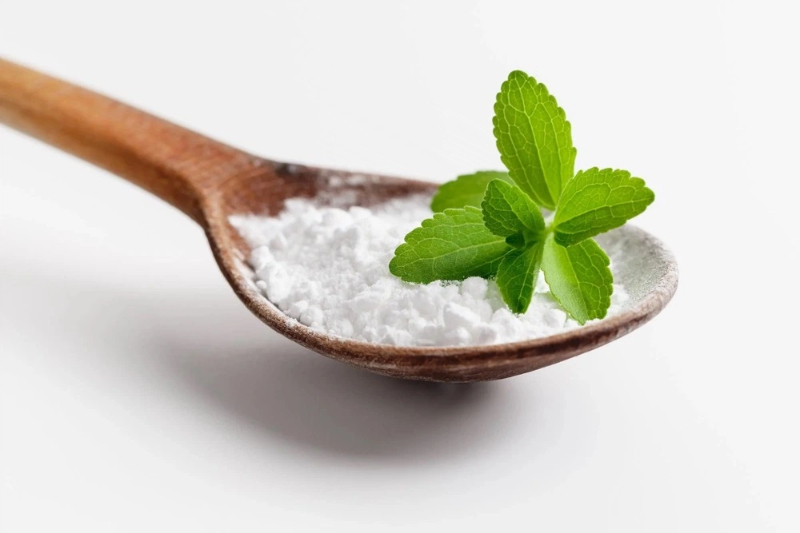







Content Menu
● Distinguishing Stevia from Sugar Alcohols
● Applications in Your Business
● Quality and Regulatory Considerations
● Taste and Sensory Optimization
● Comparisons with Sugar Alcohols
● Is Stevia Safe for Diabetics and General Health?
● Practical Guidelines for Implementation
● Case Studies and Market Trends
● Manufacturing and Process Considerations
● Environmental and Sustainability Angles
● FAQ
>> 1. Is Stevia safe for long-term use?
>> 2. Does Stevia cause digestive issues like sugar alcohols?
>> 3. Can Stevia be used in baking?
>> 4. How does Stevia affect taste compared to sugar?
>> 5. What are best practices for labeling Stevia-containing products?
Stevia has emerged as one of the most discussed natural sweeteners in modern food and health product development. Many people wonder whether Stevia is a sugar alcohol or something entirely different. The answer is clear: Stevia is not a sugar alcohol. It is a natural sweetener derived from the leaves of the Stevia rebaudiana plant, containing compounds called steviol glycosides that provide sweetness without calories. This article explores the science, applications, and market implications of Stevia, how it compares with sugar alcohols, and how manufacturers—especially those in food, beverage, and healthcare sectors—can integrate Stevia into blended sweeteners, tablets, and OEM/ODM formulations.

Stevia refers to the leaves of the Stevia rebaudiana plant, from which sweet compounds are extracted. The primary sweet constituents are steviol glycosides, including rebaudioside A (Reb A) and stevioside, among others. These compounds exhibit intense sweetness with minimal or zero calories and do not raise blood glucose levels in the same way as table sugar (sucrose). Unlike sugar alcohols, Stevia does not cause gastrointestinal distress at typical usage levels, though some individuals may notice a preferred aftertaste or bitter notes at higher concentrations.
Structure and source:
- Stevia: natural glycosides extracted from plant leaves; non-caloric sweeteners.
- Sugar alcohols (polyols): synthetic or semi-synthetic compounds such as xylitol, sorbitol, erythritol, mannitol; provide fewer calories than sugar but can affect digestive tolerance.
Sweetening profile:
- Stevia: very high sweetness intensity; often used in nano- or micro-encapsulated forms for stability and taste masking.
- Sugar alcohols: milder sweetness, bulk-providing, sometimes used as partial sugar replacements with cooling or laxative effects at high doses.
Digestive effects:
- Stevia: generally well tolerated; no significant osmotic effects.
- Sugar alcohols: may cause bloating or laxative effects in some consumers, especially at higher intakes.
Applications:
- Stevia: beverages, tabletop sweeteners, baked goods, dairy, and healthcare formulations with taste-masking needs.
- Sugar alcohols: confectionery, chewing gums, oral care products, and formulations needing bulking properties.
Your factory specializes in natural sweeteners, functional polyols, and dietary fiber, with services in blended-sweetener development, tablet production, and OEM/ODM for overseas manufacturers. Stevia can play a central role in several product pathways:
- Blended sweeteners: combine Reb A- or Reb D-based Stevia blends with natural bulking agents to achieve sugar-like mouthfeel without calories. Include taste modifiers to minimize aftertaste.
- Tablet production: Stevia-based tablets can be formulated with binders and disintegrants to deliver precise sweetness in dosage forms, including nutraceuticals and dietary supplements.
- OEM/ODM sweetener solutions: develop customized Stevia blends tailored to target markets, with clean-label claims and label-friendly ingredients.
- Dairy and beverages: use Stevia to create zero- or low-calorie beverages and dairy products with sugar-reduction targets.
- Healthcare products: formulate Stevia-sweetened health foods and supplements that appeal to brands seeking natural, low-calorie ingredients.

- Regulatory status: Stevia glycosides are approved in many markets as Generally Recognized As Safe (GRAS) or approved sweeteners, subject to jurisdiction-specific labeling and permissible usage levels.
- Purity and labeling: ensure high Reb A concentration and purity to maintain taste quality; label as "steviol glycosides" or "Stevia extract."
- Allergen considerations: Stevia is plant-derived; cross-contact risks should be managed in manufacturing facilities handling other allergenic ingredients.
- Clean-label trends: Stevia aligns with clean-label demands, particularly when combined with natural flavors and minimal processing aids.
- Bitterness masking: microencapsulation and blending with other natural sweeteners can mitigate aftertaste.
- Mouthfeel: pairing Stevia with bulking agents (e.g., dietary fibers or polyols) to approximate sugar's body and viscosity without calories.
- Temperature stability: Stevia stability varies with heat; formulation strategies include protective carriers and controlled-release matrices.
- Consumer preference signals: some markets prefer Reb A-dominant blends for a cleaner aftertaste, while others respond well to Reb D and Reb M blends for a more sugar-like profile.
| Aspect | Stevia | Sugar Alcohols |
|---|---|---|
| Source | Plant extract (steviol glycosides) | Synthetic or natural polyols |
| Calories | Zero or near-zero | 0.2–3 kcal/g depending on type |
| Digestive effects | Generally none | Possible laxative effect at high doses |
| Sweetness intensity | Very high; requires dilution | Moderate to high, additive-based sweetness |
| Common uses | Beverages, baked goods, dairy, supplements | Confectionery, gum, oral care, bulking in low-sugar products |
| Labeling | "Stevia extract" or "steviol glycosides" | "Sugar alcohol" or specific name (xylitol, sorbitol, etc.) |
Stevia is widely studied for its non-glycemic response, making it a preferred option for people managing blood sugar. It does not raise blood glucose or insulin levels significantly in most individuals, which supports its use in diabetic-friendly formulations. However, safety assessments focus on extract purity, long-term consumption, and potential interactions with medications. As with any ingredient, moderation and product-specific studies help ensure consumer safety and satisfaction.
- Global flavor preferences vary: markets in Asia often embrace stronger Reb A blends, while European consumers may prefer Reb D/M-rich profiles for a closer sugar-like sweetness.
- Sensory studies: consumer panels consistently note Stevia's aftertaste at high concentrations; successful products deploy taste-masking agents, blends with natural flavors, and controlled sweetness release.
- Labeling and perception: clean-label positioning emphasizes natural origin, plant-based sourcing, and minimal processing; certifications (Non-GMO, organic where applicable) can enhance appeal.
- Determine target use level: establish the maximum sweetness concentration needed to reach the desired taste profile for your product.
- Choose a Stevia form: Reb A-dominant blends for clean taste; Reb D/M-rich blends for broader palatability; consider microencapsulation for stability.
- Plan for cost and supply: secure consistent supply of high-purity steviol glycosides; assess cost implications relative to sugar and polyols.
- Test across formats: evaluate Stevia in beverages, tablets, and solids; monitor dissolution, mouthfeel, and flavor release in each format.
- Compliance and labeling: align with regional regulations; include clear labeling to reflect clean-label positioning.
- Beverages: Low-calorie and zero-calorie drinks increasingly rely on Stevia blends to achieve sugar-like sweetness without calories, supporting health claims and consumer wellness goals.
- Baked goods: Stevia's heat stability and taste masking enable baking applications, though formulation must address potential bitterness and aftertaste at high concentrations.
- Healthcare products: Stevia-sweetened nutraceuticals and dietary supplements offer consumer-friendly alternatives to sugar, aiding compliance with sugar-reduction trends.
- Sourcing: partner with Stevia suppliers who provide consistent Reb A purity and compliance documentation.
- Processing: ensure extraction and refinement steps preserve sweetness while minimizing off-notes.
- Formulation: develop robust blends that balance sweetness, mouthfeel, and aftertaste, using supportive ingredients such as natural flavors and dietary fibers.
- Quality control: implement stringent QC for glycoside purity, moisture, aroma, and microbial limits.
- Plant-forward sourcing: Stevia aligns with sustainability goals due to natural origin and lower processing compared to some synthetic sweeteners.
- Packaging and lifecycle: consider packaging that preserves flavor integrity; promote sustainable sourcing narratives in marketing materials.
Stevia is not a sugar alcohol, but a natural, zero-calorie sweetener derived from the Stevia rebaudiana plant. Its potency, combined with clean-label appeal and regulatory acceptance in many markets, makes Stevia an excellent backbone for blended sweeteners, tablet formulations, and OEM/ODM sweetener solutions in food, beverage, and healthcare applications. By carefully choosing Stevia blends, masking aftertastes, and pairing with compatible ingredients, manufacturers can deliver delicious, calorie-conscious products that meet evolving consumer demands.

Yes, when used within regulatory guidelines and at approved sweetener levels, Stevia is considered safe for long-term consumption in most populations.
Stevia is generally well tolerated, and unlike many sugar alcohols, it does not typically cause laxative effects at standard usage levels.
Yes, Stevia can be used in baking, especially when formulated as robust blends; heat stability depends on the specific steviol glycoside profile and formulation.
Stevia provides intense sweetness with a different aftertaste compared to sugar; proper masking and blending can achieve a sugar-like flavor profile.
Label as "Stevia (steviol glycosides)" or "Stevia extract," and ensure compliance with local regulatory labeling requirements.
